Transfer AVAX Between the X-Chain and P-Chain
Introduction
AVAX tokens exist on the X-Chain, where they can be traded, on the P-Chain, where they can be provided as a stake when validating the Primary Network, and on the C-Chain, where they can be used in smart contracts or to pay for gas. Avalanche supports movement of AVAX between these chains, and in the future, Avalanche will support more generic atomic swaps between chains. In this tutorial, we’ll send AVAX tokens between the X-Chain and P-Chain.
Requirements
You've completed Getting Started and are familiar with Avalanche's architecture.
In order to send AVAX, you need to have some AVAX! You can get real AVAX by buying it on an exchange, or you can get testnet AVAX from the AVAX Test Faucet, which is a free and easy way to get to play around with Avalanche.
Transferring AVAX Using the Web Wallet
The easiest way to transfer AVAX between chains is to use the Avalanche Wallet, which is a non-custodial and secure way to access and move AVAX.
The Avalanche Wallet source code can be found here.
Step 1 - Open the Avalanche Wallet

Select Access Wallet to enter your wallet. To connect the wallet to a network other than the main Avalanche network, select Mainnet and choose the network to connect to.
Step 2 - Log In to Your Wallet
You can access your wallet using the private key, mnemonic key phrase, keystore file or Ledger Nano S.
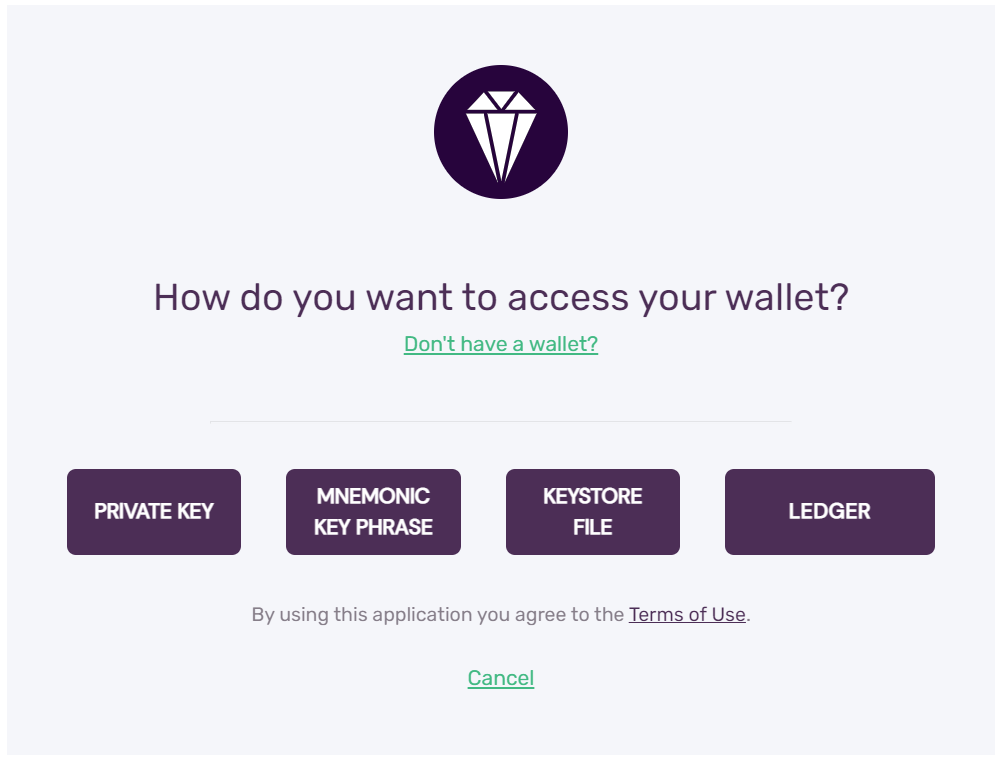
After a successful login you will see your balance, assets portfolio and various other information.
Step 3 - Go to the Cross Chain Tab
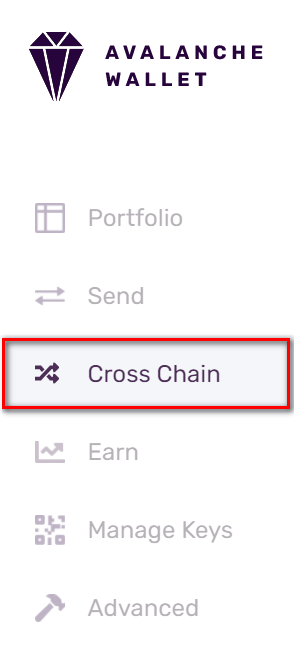
Functionality for transferring tokens between chains is on the Cross Chain tab.
Step 4 - Enter Amount to Transfer
You will be presented with a choice for Source Chain and Destination Chain. Select X-Chain and P-Chain, respectively. You will see your X and P balances, and an input field for entering the amount to transfer from source to destination chain.
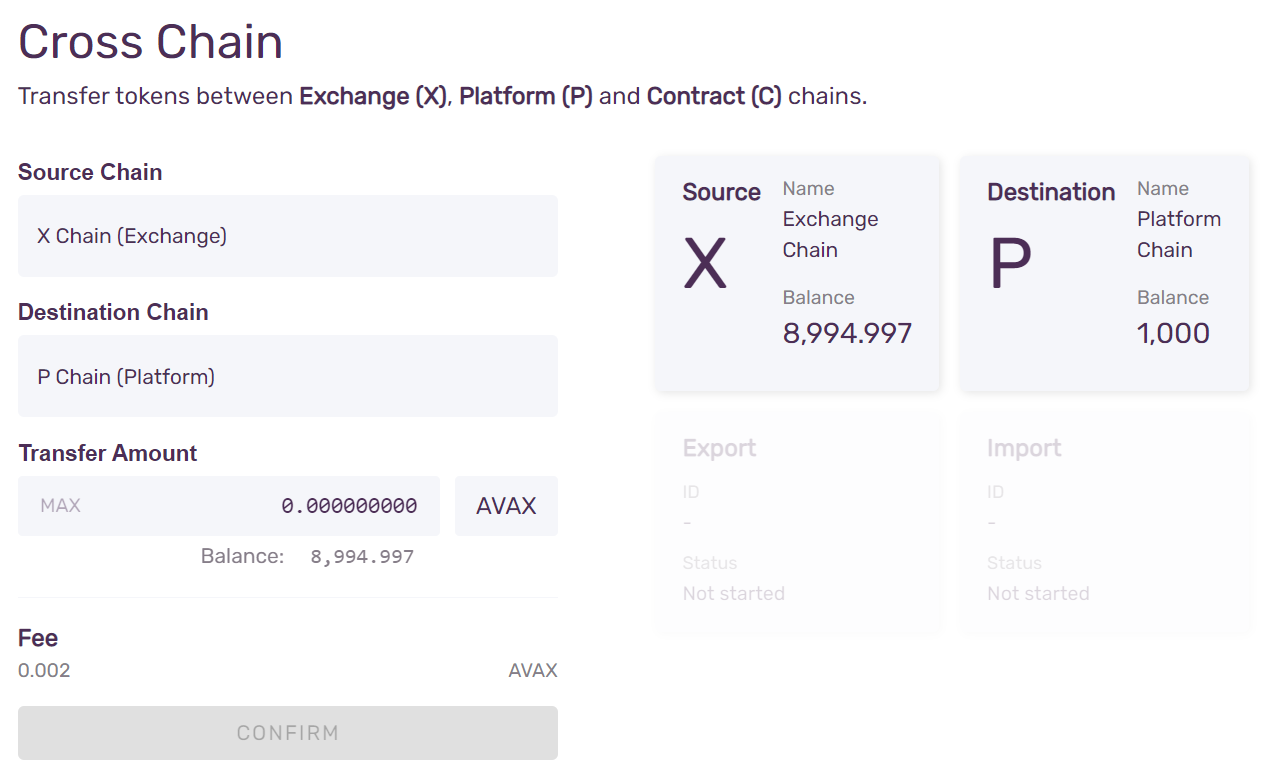
Enter the amount you wish to transfer from the X-Chain to the P-Chain.
Step 5 - Confirm the Transaction
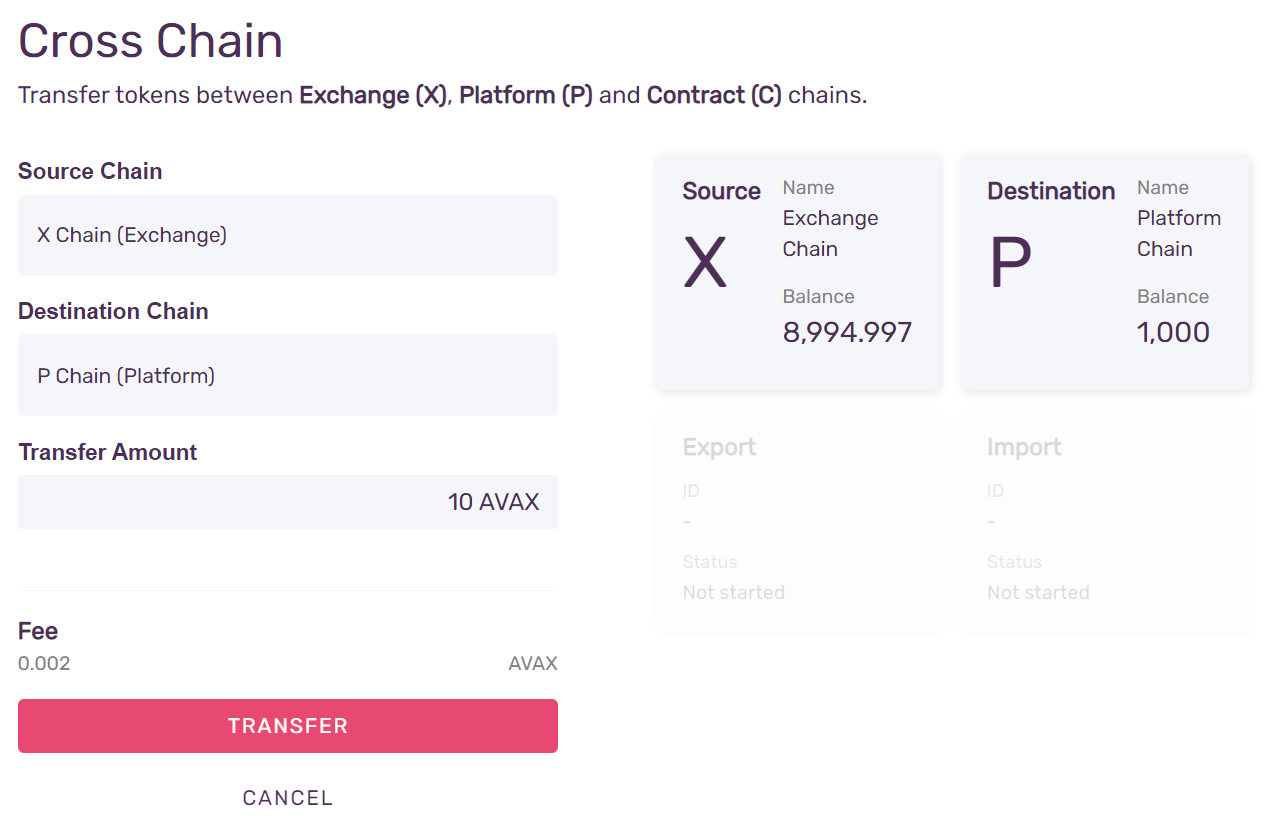
Press Confirm, and then Transfer to initiate the transfer.
Step 6 - Done!
A cross-chain transfer is a two step process: first a transaction to export the funds from the X-Chain, and another to import it to the P-Chain. The wallet will do both and show its the progress while doing so.
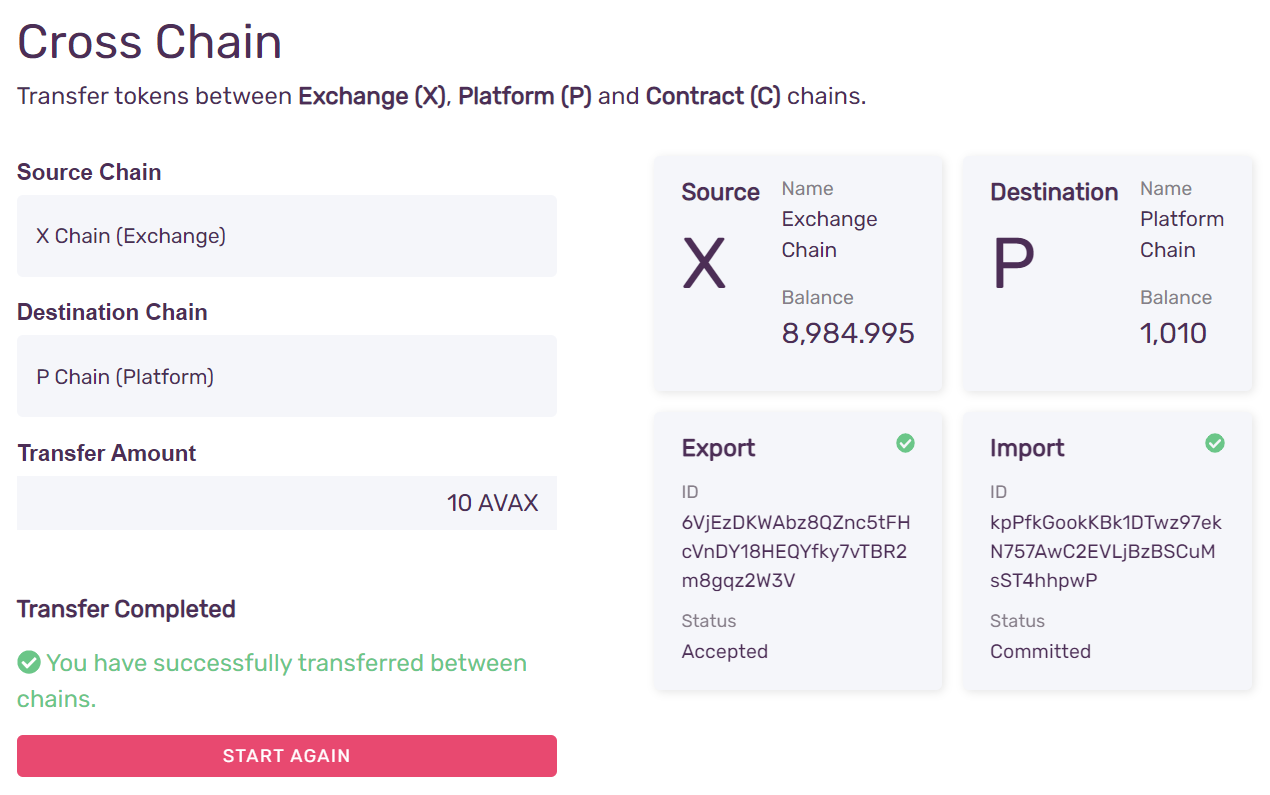
That's it! You've transferred AVAX from the X-Chain to P-Chain! Now you can use them to validate or delegate on the Avalanche network.
Transfer from P-Chain to X-Chain
To return the AVAX back to the X-Chain, you need to do the transfer in the opposite direction.
Swap the source and destination chains by selecting them from the Source and Destination drop-down menu. The rest of the process is the same: enter the amount, confirm and transfer.
Transferring from the X-Chain to P-Chain with API Calls
If you're building an application on the Avalanche network, you may want to do the transfer programmatically as part of some broader functionality. You can do that by calling the appropriate APIs on an AvalancheGo node. The rest of the tutorial assumes you have access to an AvalancheGo node, AVAX tokens on the X-Chain, and user credentials created and stored in the node's keystore.
All the example API calls below assume the node is running locally (that is, listening on 127.0.0.1). The node can be connected to the main network, a test network or a local network. In each case, the API calls and responses should be the same, except for the address formats. The node need not be local; you can make calls to a node hosted elsewhere.
As you may have noticed while transferring AVAX using the Avalanche Wallet, a cross-chain transfer is a two transaction operation:
- Export AVAX from the X-Chain
- Import AVAX to the P-chain
Step 1 - Export AVAX from the X-Chain
To export AVAX, call the X-Chain’s avm.export method with AVAX assetID.
Your call should look like this:
curl -X POST --data '{
"jsonrpc":"2.0",
"id" :1,
"method" :"avm.export",
"params" :{
"to":"P-avax1wkmfja9ve3lt3n9ye4qp3l3gj9k2mz7ep45j7q",
"assetID": "AVAX",
"amount": 5000000,
"changeAddr": "X-avax1turszjwn05lflpewurw96rfrd3h6x8flgs5uf8",
"username":"myUsername",
"password":"myPassword"
}
}' -H 'content-type:application/json;' 127.0.0.1:9650/ext/bc/X
where to is the address of a P-Chain address your user controls and changeAddr is the address to send any change to. You can leave changeAddr blank; if you leave it blank, change will be returned to an address controlled by your user (see here for instructions on creating a new P-Chain address).
Note that you will pay a transaction fee for both the export and import operations. In this example, let’s assume the transaction fee is .001 AVAX. Then, the above export actually consumes .006 AVAX; .005 goes to the P-Chain and .001 is burned as a transaction fee.
Make sure that the amount that you’re sending exceeds the transaction fee. Otherwise, when you import AVAX on the P-Chain, it will consume the transaction fee, and you’ll end up with less AVAX on the P-Chain.
The response should look like this:
{
"jsonrpc": "2.0",
"result": {
"txID": "MqEaeWc4rfkw9fhRMuMTN7KUTNpFmh9Fd7KSre1ZqTsTQG73h",
"changeAddr": "X-avax1turszjwn05lflpewurw96rfrd3h6x8flgs5uf8",
},
"id": 1
}
We can verify that this transaction was accepted by calling avm.getTxStatus:
curl -X POST --data '{
"jsonrpc": "2.0",
"method": "avm.getTxStatus",
"params":{
"txID":"MqEaeWc4rfkw9fhRMuMTN7KUTNpFmh9Fd7KSre1ZqTsTQG73h"
},
"id": 1
}' -H 'content-type:application/json;' 127.0.0.1:9650/ext/bc/X
Which shows our transaction is accepted:
{
"jsonrpc": "2.0",
"result": {
"status": "Accepted"
},
"id": 1
}
We can also call avm.getBalance to check that the AVAX was deducted from an address held by our user:
curl -X POST --data '{
"jsonrpc":"2.0",
"id" :1,
"method" :"avm.getBalance",
"params" :{
"address":"X-ADDRESSGOESHERE",
"assetID":"AVAX"
}
}' -H 'content-type:application/json;' 127.0.0.1:9650/ext/bc/X
The amount deducted is the exported amount (.005 AVAX in this example) plus the transaction fee. If your user controls multiple X-Chain addresses, AVAX may have been sent from any combination of them.
Step 2 - Import AVAX to the P-Chain
Our transfer isn’t done just yet. We need to call the P-Chain’s platform.importAVAX method to finish the transfer.
Your call should look like this:
curl -X POST --data '{
"jsonrpc": "2.0",
"method": "platform.importAVAX",
"params": {
"to":"P-avax1wkmfja9ve3lt3n9ye4qp3l3gj9k2mz7ep45j7q",
"sourceChain":"X",
"changeAddr":"P-avax103y30cxeulkjfe3kwfnpt432ylmnxux8r73r8u",
"username":"myUsername",
"password":"myPassword",
},
"id": 1
}' -H 'content-type:application/json;' 127.0.0.1:9650/ext/bc/P
This returns the transaction ID:
{
"jsonrpc": "2.0",
"result": {
"txID": "2sxo3ySETZ4xzXqAtgsUvZ5pdkqG4SML4c7Z7NoKLZcp77YNXC",
"changeAddr":"P-avax103y30cxeulkjfe3kwfnpt432ylmnxux8r73r8u"
},
"id": 1
}
We can check that the transaction was accepted with:
curl -X POST --data '{
"jsonrpc":"2.0",
"id" :1,
"method" :"platform.getTxStatus",
"params" :{
"txID":"2sxo3ySETZ4xzXqAtgsUvZ5pdkqG4SML4c7Z7NoKLZcp77YNXC"
}
}' -H 'content-type:application/json;' 127.0.0.1:9650/ext/bc/P
It should be Committed, meaning the transfer is complete. We can also check the balance of the address with:
curl -X POST --data '{
"jsonrpc": "2.0",
"method": "platform.getBalance",
"params":{
"address":"P-avax1wkmfja9ve3lt3n9ye4qp3l3gj9k2mz7ep45j7q"
},
"id": 1
}' -H 'content-type:application/json;' 127.0.0.1:9650/ext/bc/P
The response should look like this:
{
"jsonrpc": "2.0",
"result": {
"balance": "4000000",
"utxoIDs": [
{
"txID": "2sxo3ySETZ4xzXqAtgsUvZ5pdkqG4SML4c7Z7NoKLZcp77YNXC",
"outputIndex": 0
}
]
},
"id": 1
}
Note that the balance we see is the amount exported from the X-Chain (.004 AVAX) less the transaction fee (.001 AVAX in this example). Now, we can use the AVAX held by this P-Chain address to provide a stake in order to validate the Primary Network.
Transferring from the P-Chain to X-Chain programmatically
Now, let’s move AVAX from the P-Chain back to the X-Chain.
Same as before, this is also a two transaction operation:
- Export from the P-Chain
- Import to the X-Chain
Step 1 - Export AVAX from the P-Chain
To do so, call platform.exportAVAX:
curl -X POST --data '{
"jsonrpc": "2.0",
"method": "platform.exportAVAX",
"params": {
"to":"X-avax1fjn5rffqvny7uk3tjegjs6snwjs3hhgcpcxfax",
"amount":3000000,
"changeAddr":"P-avax103y30cxeulkjfe3kwfnpt432ylmnxux8r73r8u",
"username":"myUsername",
"password":"myPassword"
},
"id": 1
}' -H 'content-type:application/json;' 127.0.0.1:9650/ext/P
where to is the X-Chain address the AVAX is being sent to.
This returns the transaction ID, and we can check that the transaction was committed with another call to platform.getTxStatus. Again, make sure that the amount you’re sending exceeds the transaction fee.
Step 2 - Import AVAX to X-Chain
To finish our transfer from the P-Chain to the X-Chain, call avm.import:
curl -X POST --data '{
"jsonrpc":"2.0",
"id" :1,
"method" :"avm.import",
"params" :{
"to":"X-avax1fjn5rffqvny7uk3tjegjs6snwjs3hhgcpcxfax",
"sourceChain":"P",
"changeAddr": "X-avax1turszjwn05lflpewurw96rfrd3h6x8flgs5uf8",
"username":"myUsername",
"password":"myPassword"
}
}' -H 'content-type:application/json;' 127.0.0.1:9650/ext/bc/X
Note that to is the same address specified in our call to platform.exportAVAX.
Just as before, we can call avm.getBalance to verify the funds were received. The balance should have increased by .003 AVAX minus the transaction fee.
Wrapping Up
That’s it! Now, you can swap AVAX back and forth between the X-Chain and P-Chain, both by using the Avalanche Wallet, and by calling the appropriate API calls on an Avalanche node.
Now you can use the tokens on the P-Chain to add a node as a validator on the Primary Network.